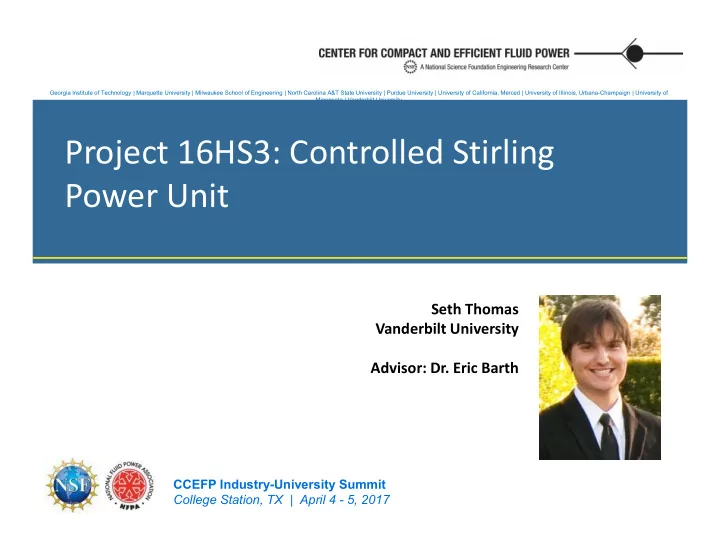

Georgia Institute of Technology | Marquette University | Milwaukee School of Engineering | North Carolina A&T State University | Purdue University | University of California, Merced | University of Illinois, Urbana-Champaign | University of Minnesota | Vanderbilt University Project 16HS3: Controlled Stirling Power Unit Seth Thomas Vanderbilt University Photo Advisor: Dr. Eric Barth CCEFP Industry-University Summit College Station, TX | April 4 - 5, 2017
Rationale • Goal: Portable, untethered, high-energy-density power supply for human-scale robotic applications. Li-ion Batteries with Hydrocarbons with Servomotors Controlled Stirling Power Unit Fuel source 700 kJ/kg Fuel source 45,000 kJ/kg energy density energy density Efficiency of energy ~50% - 90% Efficiency of energy ~8% - 10% conversion and conversion, Stirling actuation via DC cycle, and hydraulic motors actuation (estimate) Specific mechanical ~350-630 kJ/kg Specific mechanical ~3600-4500 output output kJ/kg 2
Stirling Engine Cycle 3
Stirling Engine Variants Kinematic Dynamic Displacer Piston Displacer Piston Power Piston Power Piston 4
Stirling Power Unit Design heater head • Controlling displacer piston with Sealed Engine Section linear motor Inconel engine • Return chamber is connected to cylinder the engine section via an orifice displacer piston plate cooling fins • Helium is used as the working fluid - better heat transfer extension rod properties than air power connection Return chamber • Electric heaters for accurate ports (not shown ) temperature control shaft coupling • Engine cylinder housing made linear motor from Inconel 5
Thermocompressor Principles Stirling engine vs. Stirling Thermocompressor Design of Stirling Power Unit hot side hot side Regenerator/ Regenerator/ Displacer Displacer cold side cold side power check piston valves 6
Return chamber Sealed Engine Section Dynamic Model 7
Model Validation Setup heater head Sealed Engine Section Cartridge heaters Inconel engine cylinder displacer piston cooling fins Thermocouple PCB Pressure sensor extension rod Needle valve Kulite Pressure sensor power connection 3 way ball valve Return chamber ports (not shown ) Motor leads Helium inlet shaft coupling Temperature control linear motor 8
Experimental Results • Heater head temperature 250 C • Average engine pressure 10 bar • Displacer frequency of 2 Hz Sinusoidal motion profile Square wave motion profile 9
Experimental Results • Heater head temperature 500 C • Average engine pressure 20 bar • Displacer frequency of 2 Hz Sinusoidal motion profile Square wave motion profile 10
Control Parameters - He 2,526 kPa 131 kPa 11
Control Parameters - He 22.4 % 3.0 % 12
2nd Generation Design • Increase Frequency of Oscillating Displacer Piston – Limitations of current linear motor 13
2nd Generation Design • Streamlined Profile – Ports for instruments unnecessary – Smaller, more compact design • Difficulties in Managing Helium – Costly and difficult to seal – Air is relatively easy to use 14
Control Parameters - Air 1,102 kPa 102 kPa 15
Control Parameters - Air 13.6 % 0.6 % 16
Multi-Stage Model Tank P atm 17
Multi-Stage Simulation 18
Multi-Stage Simulation 19
Next Steps • Continue to design the 2 nd generation prototype setup, using air as the working fluid. • Fabricate 2 nd generation prototype (late May/early June) and experimentally characterize its performance. (Sept. 2017) • Design and fabrication of hydrocarbon heater. (Jan. 2018) • Final high energy density Stirling device design complete. (May 2018) 20
Conclusions • Used validated model for simulation of control parameter space and multi-stage design. – High temperature difference is essential to high efficiency and high power output – High median engine pressure is largely responsible for large final pressure differences between high and low pressure tanks – Mid-to-low frequencies result in higher overall efficiencies, given current setup – Using air in a multi-stage design has potential 21
Contact Information • Seth Thomas – benjamin.s.thomas@vanderbilt.edu • Dr. Eric J. Barth – eric.j.barth@vanderbilt.edu 22
Recommend
More recommend